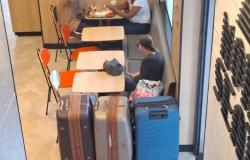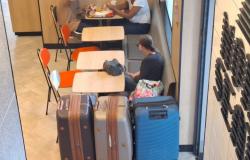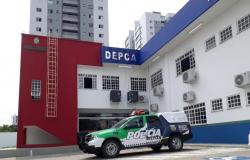At the top of the Quadrado, life drags on at its usual pace. But, at sea level, Trancoso displays its most isolated and unknown version.
It is on the beaches of the southern coast of Bahia, where cars do not enter and bathers only arrive with some effort, that bike crossings take place between Porto Seguro and Caraíva, a journey of almost 50 kilometers, made on two wheels and combined with a trail , in the final section.
Itaquena Beach
Photo: Eduardo Fessoni / Viagem em Pauta
Expect to find extensive stretches of sand where you and your guide will be the only ones, natural pools that emerge right at the edge of the beach, cliffs that rise above our heads and a series of other scenarios that can only be seen by those who arrive on foot or by car. bicycle.
Below, you can discover two exclusive itineraries aboard a skinny boat (between Porto Seguro and Trancoso, and another from there to Praia da Espelho), and an 11 kilometer walk, between Espelho and Caraíva.
South coast of Bahia
⇒ Porto Seguro – Trancoso (18.1 km)
The crossing begins in Porto Seguro, the nervous center of the southern coast of Bahia that exchanged the serenity of its calm waters to get drunk on the street that became a walkway, and continues to Caraíva, almost 50 kilometers later.
After crossing the Buranhém River by ferry to Arraial d’Ajuda, cyclists continue along the firm sands of Apaga-Fogo beach.
In this first six kilometer long stage, travelers also pass by the beaches of Araçaípe, Delegado, dos Pescadores, Mucugê, Pitinga and Taípe, all in Arraial d’Ajuda.
The altitude variations are small and the terrain is made of packed sand, which makes it a lot easier, especially when suitable winds give a little push.
This stretch is also marked by long coral barriers that contain warm waters, in natural pools, and a sea of weak waves and vegetation with almond and coconut trees, whose shades serve as a refuge during hours of strong sun.
Pitinga Beach, in Arraial d’Ajuda
Photo: Eduardo Vessoni / Viagem em Pauta
From Pitinga, the journey takes on wilder scenery, marked by firm sand, natural pools of warm water and strong waves that break on the reefs that border the coast.
It is there that the cliffs are cut by stretches of Atlantic Forest that merge into those walls of tones that range from light to orange.
And when the body starts to show signs of tiredness, under the sun at the most advanced position of the day and sand that sometimes brakes wheels, Rio da Barra beach, on the border with Trancoso, welcomes tired cyclists with the mouth that lends its name to the place, whose waters constantly reshape the sand strips and beaches, cannot be accessed by car.
The hard sand lined with coconut trees continues to help with cycling and the sophisticated (and expensive) Trancoso is painting at the bottom of the beach, whose first destination is Praia dos Nativos, the closest to the village.
After almost 20 kilometers of pedaling and 2h16 in constant motion, cyclists take the dirt road that crosses the Trancoso River over a rustic wooden bridge and continue uphill to Quadrado, the famous square (rectangular, remember) with the main attractions of this district of the municipality of Porto Seguro, such as the church of São João Batista, local patron saint.

Mirror Beach
Photo: Eduardo Vessoni / Viagem em Pauta
⇒ Trancoso – Praia do Espelho (20.6 km)
The bicycle trip along the southern coast of Bahia follows an increasing itinerary, which begins at more urban beaches and continues through isolated areas, between Trancoso and Praia do Espelho.
The second day is tough and requires concentration to cycle on soft sandy terrain, cross rivers and large stretches of (almost) shadeless beach, and push the bike in moments of stubborn nature.
But all the effort will be rewarded with bays with warm waters, coral barriers on the beachfront and a feeling of exclusivity that few can feel there.
This stage begins with the bucolic crossing on a wooden bridge over a mangrove that gives access to Praia dos Coqueiros, the closest strip of sand to Trancoso.
From then on, the feeling of being the only one grows, as the cyclist progresses towards the south and passes long stretches of beaches with natural pools and almost all of them without access to cars, such as Itapororoca and Itaquena, the latter located in a preserved area. , known as the Rio dos Frades Wildlife Refuge.
The next stop is at Rio dos Frades, an isolated spot, frequented only by local fishermen. There, it’s you, your skinny beach (which must be lifted to cross the river that separates the next beach) and a scenic strip of sand that calls for a longer stop.
On high tide days, you need to hire one of the local residents’ boats to cross the river (and if you don’t know how to whistle loudly to call the fisherman on the other bank, plan to bring a whistle).

Rio dos Frades
Photo: Eduardo Vessoni / Viagem em Pauta
Afterwards, cyclists also pass through Jacumã and Curuípe, whose exaggerated water tones compensate for the rigidity of what is one of the most demanding days of the entire three-day crossing along the southern coast of Bahia.
We are almost giving up on cycling under the strong sun and stretches of sand that seem to have no end, but the last destination of the second day is one of those places that make us throw the bike on the ground, take a deep breath and enjoy, paralyzed, the scenery. most popular on the itinerary: Praia do Espelho, the fictional name of Praia do Curuípe.
This exclusive part of the southern coast of Bahia is an easy figure on lists that list the best beaches in Brazil. And, to convince yourself of this, just go up to one of the viewpoints overlooking that sea of varied tones, cut out by cliffs, or lie down on one of the cushions spread across the local sand bars (all of which require a usage fee). or minimum consumption).

Juacema Beach, between Espelho and Caraíva
Photo: Eduardo Vessoni / Viagem em Pauta
⇒ Praia do Espelho – Caraíva (11 km)
On the third and final day of the trip, the bikes give way to the walk that continues to Caraíva, the most rustic and sandy version of the entire itinerary, where skinny people are not always welcome, due to the more unstable sandy terrain and trails. interiors on uneven and steep ground.
The selective sophistication of Praia do Espelho gives way to a wild scenery that looks like it dates back to the time when Cabral landed there in 1500.
In this stretch, the most isolated and impressive, cyclists pass through Praia da Juacema, Juacema River, Lagoa do Satu and Praia da Barra.
And he’s getting ready to see it all again, as if it were the first time.

Trail from Praia do Espelho to Caraíva
Photo: Eduardo Vessoni / Viagem em Pauta
Long golden strips, twisted coconut trees that almost touch the sea, waters that go from green to shades we can’t describe, shallow pools for swimming and nothing or no one else.
It is not always possible to swim in the sea, in those areas with open and rough seas, but Juacema and Lagoa do Satu serve as a refuge for snack time on the trail and for diving in fresh waters.
Crossed by the river of the same name, the district of Caraíva points towards the bottom, isolated from other Bahian addresses that have embraced modern facilities.
Despite the mass tourism that has threatened this old stronghold of alternative travelers, 120 km from Porto Seguro, it is Bahia that does not leave us wanting to return home, that invites us to walk along narrow sandy streets that border the river and trace the colorful houses with simple facades.
Cars do not enter there, they must be parked in Nova Caraíva, on the other bank of the river, and transport managed by Pataxós is still done in wooden canoes, on the backs of animals or in carts.
GET READY
– It doesn’t matter what month of the year it is to put the skinny ones in the sand. The most important thing is the phase of the Moon, such as Full and New, which provide greater stretches of sand for cycling.
– Be strict when pedaling, as the tide tends to cover some stretches of beach at certain times of the day.
– Although it is difficult to have full days of rain, the rainy season on the south coast of Bahia is usually between June and August.
– To participate in bicycle crossings, you do not need to be a cyclist or athlete, but you must be in good physical shape, perform physical activities frequently and be at least 15 years old.

Photo: Viagem em Pauta / Viagem em Pauta
– As it is not always possible to spend the night at your home hotel, take a small backpack with bathing suit, light clothing, sunscreen, cap, repellent and personal hygiene items.
– The routes do not have a support car, due to the isolated beaches, but groups of at least two cyclists are accompanied by two guides.
– Reservations must be made up to 24 hours in advance and it is recommended to arrive in Porto Seguro the day before, as these routes start very early.
– Yes, it is safe to cycle on those isolated beaches, both in the more urbanized areas and in the areas where security guards at inns and residences carry out surveillance.
KNOW MORE
The Bahia Active agency, specialized in cycle tourism and trekking, offers routes of different degrees of difficulty and distances along the Discovery Coast, the origin of Brazil’s history and listed as a World Natural Heritage Site by Unesco.
The service includes individual insurance, transfers, cycle tour driver, trail snack, water and isotonic drink, and bike with helmet.
bahiaactive.com.br
+The best content in your email for free. Choose your favorite Terra Newsletter. Click here!












